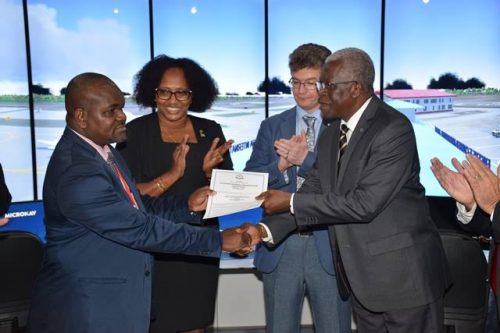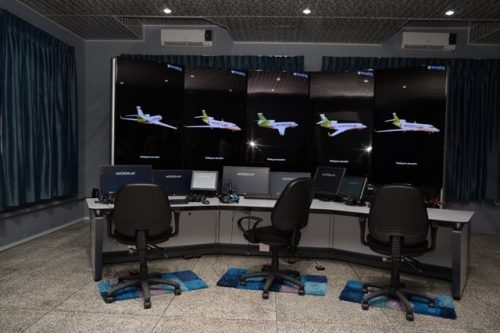The Guyana Civil Aviation Authority (GCAA) on Thursday certified its civil aviation training school and commissioned its recently-acquired simulator.
The GCAA, in a press statement, said the Civil Aviation Training School (CATS) received its accreditation at a simple ceremony held at the Air Traffic Control Tower, Cheddi Jagan International Airport (JIA), Timehri.
Formerly known as the Guyana Air Traffic Services Training School and more recently as the Air Navigation Services Training School, the CATS was originally established in 1979 and certified by the International Civil Aviation Organization (ICAO).
It provided training for almost four decades, however, the school lost its certification over time. Notwithstanding the setback, the school continued to provide training to ICAO standards, producing persons who were able to secure jobs as Air Traffic Controllers in other jurisdictions, and who have been commended for their skills, knowledge and aptitude.

Delivering the feature address at the event was Minister within the Ministry of Public Infrastructure Annette Ferguson, who noted that the certification of the school means that the institution will be able to offer courses approved and recognized by the ICAO.
She also commended the staff of the GCAA for their hard work and dedication in getting the school re-certified to ICAO standards. “Certification by a government is critical to being an Approved Training Organization and is essential for the training of persons to acquire an air traffic control licence. It is also critical to becoming an ICAO TrainAIR Plus Centre, which is in its mandate,” the minister added.
Director General of GCAA, Lieutenant Colonel (Retired) Egbert Field, in his address, noted that the re-certification of the training institution came as a result of audits done by ICAO in 2007 and 2017, which highlighted several deficiencies, including the need for continuous training of Air Traffic Control Officers.

This year, the GCAA, with the support of the government, embarked on a planned programme focused on training of its personnel and correcting the other deficiencies highlighted by the ICAO. The sum of $113 million was budgeted for capacity building initiatives for personnel of GCAA.
Field further noted that training is not only beneficial for the individual, but also the Authority and the country, thus he encouraged the staff of GCAA to take full advantage of the training opportunities being provided so that they can meet the numerous challenges ahead and make the GCAA better equipped to discharge its function.
“I’m happy that the two main items, simulator and training school, have been completed and will continue the work done by civil aviation authority…It [training school] will commence training with the normal air navigation services but as we develop more courses they will fall under the umbrella of the school, which will include safety management systems, dangerous goods training and other courses which relate to aviation,” Field added.
Meanwhile, former acting GCAA Director Chaitrani Heralall, who initiated the idea of having the simulator, stated that in 2009, when GCAA started the air navigation services modernization programme, it became critical to have a simulator that was comparable to the operation environment to reduce the gap between training and operations.
Heralall pointed out that GCAA has been successful in acquiring the simulator after trying for many years.
“I’m very pleased that all the hard work has paid off and the government has provided the funding for the simulator,” she said.
Ferguson noted that GCAA invested $85 million to procure the state-of-the-art equipment. “This expensive equipment would not have been achieved without a formal and certified institution to carry out such training,” she said.
Stabroek News understands that the 3D ATC simulator system is also scalable, and allows the user to design exercises that support different levels of training, with special self-teach, instructor and debrief facilities.





